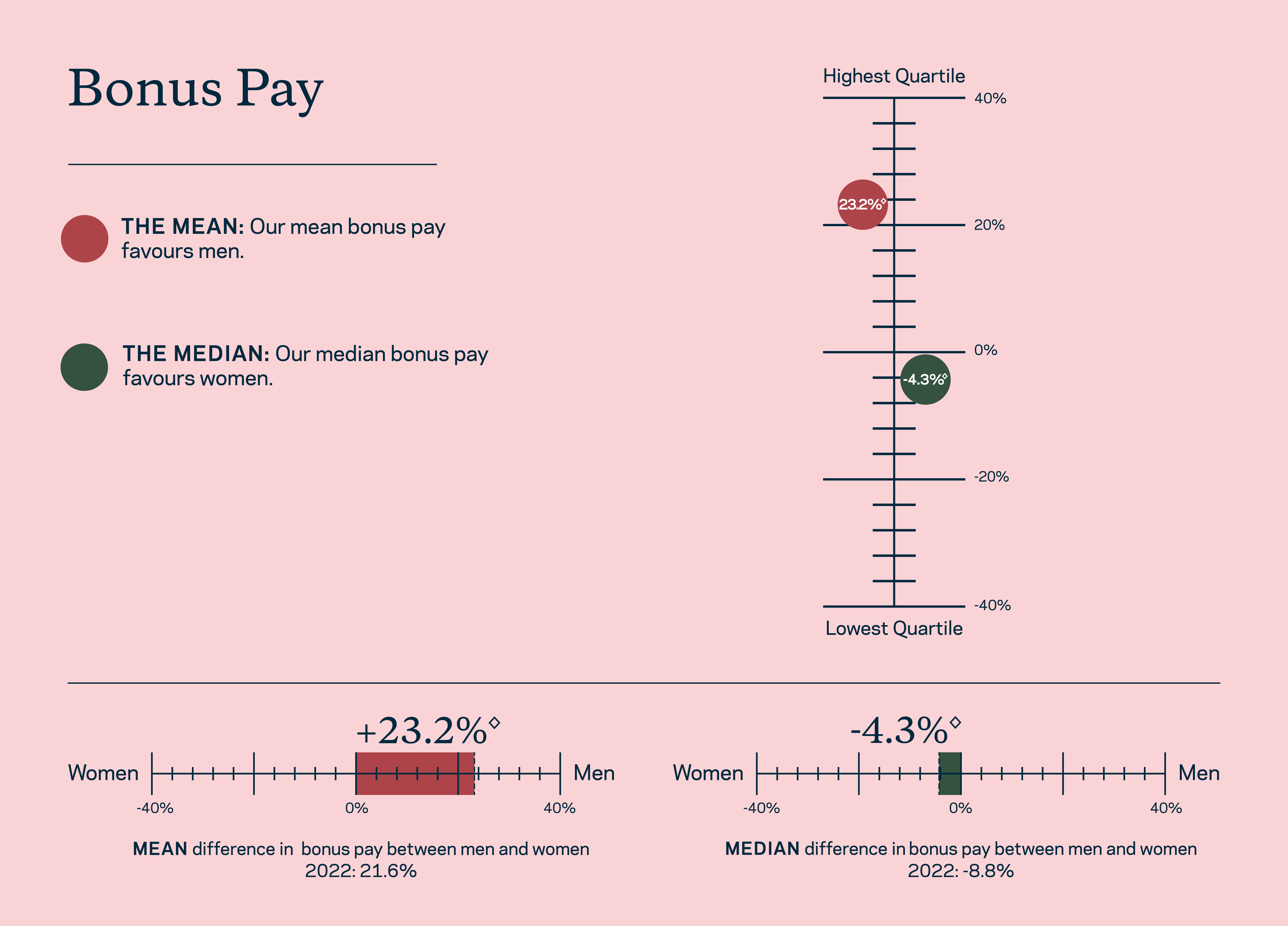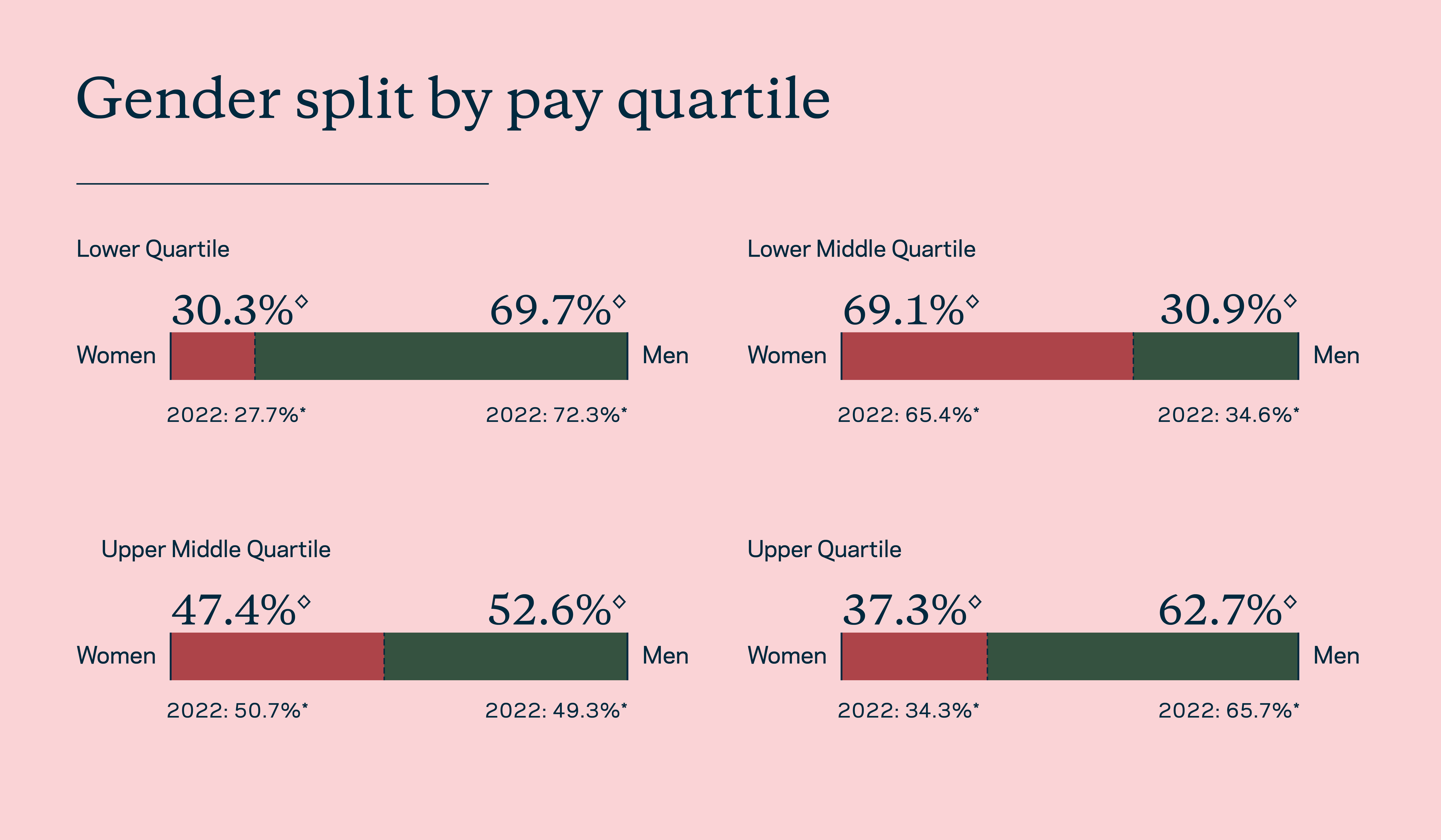
Gender pay: 2023
What is the gender pay gap?
The gender pay gap looks at the difference in the average pay between all men and women in an organisation, taking account of the full range of jobs and salaries.
It is different to equal pay, which looks at the differences between pay for men and women who carry out the same jobs, similar work, or work of equal value.
The figures reported are for 5th April 2023 the bonus figures are for 12 months leading up to 5th April 2023.
Base pay
Our mean (average) base pay gap now stands at 9.3%◊ and our median gap is 11.3%◊. These figures have increased since last year due to more women joining entry level roles during the reporting period. Overall however, the proportion of women in the business has increased to 46% during the reporting period. This is a positive step, and we are continuing to focus on diverse recruitment opportunities. Internally, we promoted more women during this reporting period and the average salary increase for women due to promotion was higher. We continue to prioritise driving positive change through talent management and progression.

Bonus pay
Our mean bonus gap is 23.2%◊ and our median gap now stands at -4.3%◊, compared to -8.8% in 2022.
Due to bonus eligibility criteria, more new employees became eligible for a bonus for the first time during the reporting period. However more men became eligible than women, with a greater percentage of men at higher job levels receiving the largest bonus percentages. This in turn has affected our bonus gap.

The proportion of women and men receiving bonuses is impacted by joiners and leavers to The Crown Estate and employees becoming eligible for a bonus for the first time.

Gender split by pay quartile
As the graphic below illustrates, we have a relatively balanced representation of men and women in the upper middle quartile of our organisation. The higher and lower levels of our pay spectrum are disproportionately men, and the lower middle quartile is disproportionately women.
Our diverse portfolio includes the Windsor Estate, where 67% of employees are men and 33% are women. The distribution of our employee base at Windsor is weighted towards males in the low pay quartile due to the composition of the operative work force in Windsor Great Park.

What are we doing to close the gender pay gap?
Over the last year we have continued to focus our efforts on closing the gap. There has been a greater focus on reviewing policies to ensure we continue to be equitable and inclusive, and as a result we’ve introduced some changes to our family policies to play our part in tackling some of the ongoing inequalities that affect underrepresented groups in the workforce and wider society.
By making enhancements to our family policies, we can ensure employees are fairly treated for taking time off with their families and in times of emergency. We can also ensure that we can support employees in important times in their lives thereby removing barriers to progression within the organisation. We’ve made these policies effective from day one of employment to make sure our policies are inclusive of everyone and reflect the wide range of situations people face in life.
We are continuing with coaching to those returning to work following parental leave, and have broadened this to include adoption leave, helping all employees who take leave at the birth or adoption of their children to reconnect and successfully return to their roles and the business.
Analysing our recruitment data allows us to understand how our recruitment processes attract different groups and identify any barriers that exist for underrepresented groups. We’ve introduced new inclusive hiring guides to support managers, along with inclusive recruitment training for our people and culture team.
We have developed 3-year diversity, equity and inclusion targets focussed on ethnicity, gender (at leadership level) and disability. By setting targets in these areas, we can positively drive improvement over time, reaching our ambition to be a more diverse organisation.
For more information on how we calculate our Gender Pay Gap, please see our reporting methodology document.
Limited Assurance: KPMG LLP has provided independent limited assurance over selected gender pay gap data highlighted on this webpage with the symbol ◊, using the assurance standard ISAE (UK) 3000. KPMG has issued an unqualified opinion over the selected data. KPMG’s full assurance statement is available below, which together with our Reporting Criteria, should be read in conjunction with the assured gender pay gap data above.
Documents download
KPMG Limited Assurance Statement 2023
Download (229KB)
Archive
Gender pay: report archive
Read more